Characterization of Early Age Curing and Shrinkage of Metakaolin-Based Inorganic Binders with Different Rheological Behavior by Fiber Bragg Grating Sensors
Abstract
:1. Introduction
2. Experimental Program
2.1. Geopolymers Binding Systems: Design and Characterization
2.2. FBGs Principle of Operation
2.3. Sensors Design
3. Experimental Results and Discussion
4. Conclusions
- Mix design optimization was realized on a different scale with respect to a typical concrete scale used for inorganic binder-based composites for both structural and non-structural applications, determining the influence of both different solid aluminosilicate precursors (namely commercial metakaolin powders) and different filler contents respect to a reference binder mixture (i.e., MK).
- In one case, i.e., in the case of MK-R, which is the geopolymeric binder obtained using flash calcined metakaolin, measurements with FBG sensors provided results with minor significance, probably associated with the very low reactivity of the designed system that was verified by observing the delayed setting and poorly developed mechanical performance at an early age. From visual inspection of the samples, MK-R exhibited also a high degree of efflorescence on the surface, confirming that this solid precursor needs a specific mix design to be performed in subsequent research studies.
- Rheological limits for the application of the developed FBG-based experimental setup were found in the system MK50, for which the formation of air bubbles became critical due to higher viscosity and yield stress with respect to other mixtures investigated in the present study. The assessment was carried out on a qualitative basis, since existing literature confirmed the empirical correlation of slump and V-funnel time with yield stress and viscosity, respectively [58,59].
- FBG-based real-time monitoring of temperature and shrinkage in simultaneous AAMK systems was successfully achieved with a high degree of accuracy, particularly with a temperature resolution of 0.1 °C and a strain resolution of 1 με.
- FBG-based real-time monitoring of early age properties can be used and further optimized for the improvement of the existing standards for the experimental characterization of both traditional and innovative binders.
Acknowledgments
Author Contributions
Conflicts of Interest
References
- Reinhardt, H.W.; Grosse, C.U. Continuous monitoring of setting and hardening of mortar and concrete. Constr. Build. Mater. 2004, 18, 145–154. [Google Scholar] [CrossRef]
- Trtnik, G.; Turk, G.; Kavčič, F.; Bosiljkov, V.B. Possibilities of using the ultrasonic wave transmission method to estimate initial setting time of cement paste. Cem. Concr. Res. 2008, 38, 1336–1342. [Google Scholar] [CrossRef] [Green Version]
- Ylmén, R.; Jäglid, U.; Steenari, B.M.; Panas, I. Early hydration and setting of Portland cement monitored by IR, SEM and Vicat techniques. Cem. Concr. Res. 2009, 39, 433–439. [Google Scholar] [CrossRef]
- Azenha, M.; Ramos, L.F.; Aguilar, R.; Granja, J.L. Continuous monitoring of concrete E-modulus since casting based on modal identification: A case study for in situ application. Cem. Concr. Compos. 2012, 34, 881–890. [Google Scholar] [CrossRef]
- Fernandes, P.; Granja, J.L.; Benedetti, A.; Sena-Cruz, J.; Azenha, M. Quality control and monitoring of NSM CFRP systems: E-modulus evolution of epoxy adhesive and its relation to the pull-out force. Compos. Part B Eng. 2015, 75, 95–103. [Google Scholar] [CrossRef] [Green Version]
- Ju, T.; Achenbach, J.D.; Jacobs, L.J.; Guimaraes, M.; Qu, J. Ultrasonic nondestructive evaluation of alkali—Silica reaction damage in concrete prism samples. Mater. Struct. 2016, 50, 60. [Google Scholar] [CrossRef]
- Colangelo, F.; Messina, F.; Cioffi, R. Recycling of MSWI fly ash by means of cementitious double step cold bonding pelletization: Technological assessment for the production of lightweight artificial aggregates. J. Hazard. Mater. 2015, 299, 181–191. [Google Scholar] [CrossRef] [PubMed]
- Ferone, C.; Colangelo, F.; Messina, F.; Iucolano, F.; Liguori, B.; Cioffi, R. Coal Combustion Wastes Reuse in Low Energy Artificial Aggregates Manufacturing. Materials 2013, 6, 5000–5015. [Google Scholar] [CrossRef] [PubMed] [Green Version]
- Nguyen, Q.A.; Hens, L. Environmental performance of the cement industry in Vietnam: The influence of ISO 14001 certification. J. Clean. Prod. 2015, 96, 362–378. [Google Scholar] [CrossRef]
- Criado, M.; Sobrados, I.; Bastidas, J.M.; Sanz, J. Corrosion behaviour of coated steel rebars in carbonated and chloride-contaminated alkali-activated fly ash mortar. Prog. Org. Coat. 2016, 99, 11–22. [Google Scholar] [CrossRef]
- Messina, F.; Ferone, C.; Colangelo, F.; Cioffi, R. Low temperature alkaline activation of weathered fly ash: Influence of mineral admixtures on early age performance. Constr. Build. Mater. 2015, 86, 169–177. [Google Scholar] [CrossRef]
- Messina, F.; Ferone, C.; Colangelo, F.; Roviello, G.; Cioffi, R. Alkali activated waste fly ash as sustainable composite: Influence of curing and pozzolanic admixtures on the early-age physico-mechanical properties and residual strength after exposure at elevated temperature. Compos. Part B 2018, 132, 161–169. [Google Scholar] [CrossRef]
- Hu, N.; Bernsmeier, D.; Grathoff, G.H.; Warr, L.N. The influence of alkali activator type, curing temperature and gibbsite on the geopolymerization of an interstratified illite-smectite rich clay from Friedland. Appl. Clay Sci. 2017, 135, 386–393. [Google Scholar] [CrossRef]
- Messina, F.; Ferone, C.; Molino, A.; Roviello, G.; Colangelo, F.; Molino, B.; Cioffi, R. Synergistic recycling of calcined clayey sediments and water potabilization sludge as geopolymer precursors: Upscaling from binders to precast paving cement-free bricks. Constr. Build. Mater. 2017, 133, 14–26. [Google Scholar] [CrossRef]
- Molino, B.; De Vincenzo, A.; Ferone, C.; Messina, F.; Colangelo, F.; Cioffi, R. Recycling of Clay Sediments for Geopolymer Binder Production. A New Perspective for Reservoir Management in the Framework of Italian Legislation: The Occhito Reservoir Case Study. Materials 2014, 7, 5603–5616. [Google Scholar] [CrossRef] [PubMed]
- Atiş, C.D.; Görür, E.B.; Karahan, O.; Bilim, C.; İlkentapar, S.; Luga, E. Very high strength (120 MPa) class F fly ash geopolymer mortar activated at different NaOH amount, heat curing temperature and heat curing duration. Constr. Build. Mater. 2015, 96, 673–678. [Google Scholar] [CrossRef]
- Ferone, C.; Colangelo, F.; Messina, F.; Santoro, L.; Cioffi, R. Recycling of Pre-Washed Municipal Solid Waste Incinerator Fly Ash in the Manufacturing of Low Temperature Setting Geopolymer Materials. Materials 2013, 6, 3420–3437. [Google Scholar] [CrossRef] [PubMed]
- Roviello, G.; Menna, C.; Tarallo, O.; Ricciotti, L.; Messina, F.; Ferone, C.; Asprone, D.; Ciof, R. Lightweight geopolymer-based hybrid materials. Compos. Part B 2017, 128, 225–237. [Google Scholar] [CrossRef]
- Migliaccio, M.; Ferrara, G.; Gifuni, A.; Sorrentino, A.; Colangelo, F.; Ferone, C.; Cioffi, R.; Messina, F.; Ingegneria, D. Shielding Effectiveness Tests of Low-Cost Civil Engineering Materials. Prog. Electromagn. Res. B 2013, 54, 227–243. [Google Scholar] [CrossRef]
- Strini, A.; Roviello, G.; Ricciotti, L.; Ferone, C.; Messina, F.; Schiavi, L.; Corsaro, D.; Cioffi, R. TiO2-Based Photocatalytic Geopolymers for Nitric Oxide Degradation. Materials 2016, 9, 513. [Google Scholar] [CrossRef] [PubMed]
- Glisic, B.; Inaudi, D. Structural monitoring of hybrid specimens at early age using fibre optic sensors. In Proceedings of the 55th Rilem Annual Week, Symposium on connections between Steel and Concrete, Stuttgart, Germany, 9–12 September 2001; pp. 1–7. [Google Scholar]
- Campopiano, S.; Iadicicco, A.; Messina, F.; Ferone, C.; Cioffi, R. Measurement of temperature and early age shrinkage of alkali activated metakaolin using fiber Bragg grating sensors. In Proceedings of the 2014 IEEE Workshop on Environmental Energy and Structural Monitoring Systems (EESMS), Naples, Italy, 17–18 September 2014; pp. 5–9. [Google Scholar]
- Liu, Z.; Zhang, Y.; Jiang, Q.; Sun, G.; Zhang, W. In situ continuously monitoring the early age microstructure evolution of cementitious materials using ultrasonic measurement. Constr. Build. Mater. 2011, 25, 3998–4005. [Google Scholar] [CrossRef]
- Wallah, S.E. Drying Shrinkage of Heat-Cured Fly Ash-Based Geopolymer Concrete. CCSE J. 2000, 3, 14–21. [Google Scholar] [CrossRef]
- Gilbert, R.I. Creep and Shrinkage Models for High Strength Concrete—Proposals for Inclusion in AS3600. Aust. J. Struct. Eng. 2002, 4, 95–106. [Google Scholar] [CrossRef]
- Pacheco-Torgal, F.; Abdollahnejad, Z.; Miraldo, S.; Baklouti, S.; Ding, Y. An overview on the potential of geopolymers for concrete infrastructure rehabilitation. Constr. Build. Mater. 2012, 36, 1053–1058. [Google Scholar] [CrossRef] [Green Version]
- Mora-Ruacho, J.; Gettu, R.; Aguado, A. Influence of shrinkage-reducing admixtures on the reduction of plastic shrinkage cracking in concrete. Cem. Concr. Res. 2009, 39, 141–146. [Google Scholar] [CrossRef]
- Cohen, M.D.; Olek, J.; Dolch, W.L. Mechanism of plastic shrinkage cracking in portland cement and portland cement-silica fume paste and mortar. Cem. Concr. Res. 1990, 20, 103–119. [Google Scholar] [CrossRef]
- Wong, A.C.L.; Childs, P.A.; Berndt, R.; Macken, T.; Peng, G.D.; Gowripalan, N. Simultaneous measurement of shrinkage and temperature of reactive powder concrete at early-age using fibre Bragg grating sensors. Cem. Concr. Compos. 2007, 29, 490–497. [Google Scholar] [CrossRef]
- Merzbacher, C.I.; Kersey, A.D.; Friebele, E.J. Fiber optic sensors in concrete structures: A review. Smart Mater. Struct. 1996, 5, 196–208. [Google Scholar] [CrossRef]
- Li, H.-N.; Li, D.-S.; Song, G.-B. Recent applications of fiber optic sensors to health monitoring in civil engineering. Eng. Struct. 2004, 26, 1647–1657. [Google Scholar] [CrossRef]
- Capoluongo, P.; Ceroni, F.; Ambrosino, C.; Campopiano, S.; Giordano, M.; Cutolo, A.; Cusano, A. Fiber Bragg Grating Sensors for Breaking Tests in Reinforced Concrete Structures Strengthened with Embedded Composite Bars. Biomed. Mater. 2005, 9506, 383–388. [Google Scholar]
- Iadicicco, A.; Campopiano, S.; Cutolo, A.; Giordano, M.; Cusano, A. Refractive index sensor based on microstructured fiber Bragg grating. IEEE Photonics Technol. Lett. 2005, 17, 1250–1252. [Google Scholar] [CrossRef]
- Iadicicco, A.; Della Pietra, M.; Alviggi, M.; Canale, V.; Campopiano, S. Deflection monitoring method using fiber bragg gratings applied to tracking particle detectors. IEEE Photonics J. 2014, 6. [Google Scholar] [CrossRef]
- Iadicicco, A.; Della Pietra, M.; Gaudio, G.; Campopiano, S. Strain measurements of a multilayer panel via Fiber Bragg gratings as novel approach for deflection monitoring of tracking particle detectors. Proc. SPIE Opt. Sens. 2015, 9506. [Google Scholar] [CrossRef]
- Iwaki, H.; Shiba, K.; Takeda, N. Structural health monitoring system using FBG-based sensors for a damage-tolerant building. Proc. SPIE 2003, 5057, 392–399. [Google Scholar]
- Whelan, M.P.; Albrecht, D.; Capsoni, A. Remote structural monitoring of the Cathedral of Como using an optical fiber Bragg sensor system. Proc. SPIE 2002, 4694, 242–252. [Google Scholar]
- Tennyson, R.C.; Mufti, A.A.; Rizkalla, S.; Tadros, G.; Benmokrane, B. Structural health monitoring of innovative bridges in Canada with fiber optic sensors. Smart Mater. Struct. 2001, 10, 560–573. [Google Scholar] [CrossRef]
- Glišić, B.; Simon, N. Monitoring of concrete at very early age using stiff {SOFO} sensor. Cem. Concr. Compos. 2000, 22, 115–119. [Google Scholar] [CrossRef]
- Glisic, B.; Inaudi, D.; Kronenberg, P.; Vurpillot, S. Dam Monitoring Using Long SOFO Sensor. In Proceedings of the Hydropower into Next Century, Gmunden, Austria, 18–20 October 1999; pp. 1–9. [Google Scholar]
- Qiu, Y.; Wang, Q.; Zhao, H.; Chen, J.; Wang, Y. Review on composite structural health monitoring based on fiber Bragg grating sensing principle. J. Shanghai Jiaotong Univ. 2013, 18, 129–139. [Google Scholar] [CrossRef]
- Leung, C.K.Y.; Wan, K.T.; Inaudi, D.; Bao, X.; Habel, W.; Zhou, Z.; Ou, J.; Ghandehari, M.; Wu, H.C.; Imai, M. Review: Optical fiber sensors for civil engineering applications. Mater. Struct. 2015, 48, 871–906. [Google Scholar] [CrossRef]
- Johny, J.; Prabhu, R.; Fung, W.K.; Watson, J. Investigation of positioning of FBG sensors for smart monitoring of oil and gas subsea structures. In Proceedings of the OCEANS 2016—Shanghai, Shanghai, China, 10–13 April 2016; pp. 2–5. [Google Scholar]
- Tapanes, E. Fibre Optic Sensing Solutions for Real-Time Pipeline Integrity Monitoring; Future Fibre Technology Pty. Ltd.: Melbourne, Australia, 2001; pp. 27–30. [Google Scholar]
- Deng, L.; Cai, C.S. Applications of fiber optic sensors in civil engineering. Struct. Eng. Mech. 2007, 25, 577–596. [Google Scholar] [CrossRef]
- Moyo, P.; Brownjohn, J.M.W.; Suresh, R.; Tjin, S.C. Development of fiber Bragg grating sensors for monitoring civil infrastructure. Eng. Struct. 2005, 27, 1828–1834. [Google Scholar] [CrossRef]
- Zou, X.; Chao, A.; Tian, Y.; Wu, N.; Zhang, H.; Yu, T.-Y.; Wang, X. An experimental study on the concrete hydration process using Fabry–Perot fiber optic temperature sensors. Measurement 2012, 45, 1077–1082. [Google Scholar] [CrossRef]
- Slowik, V.; Schlattner, E.; Klink, T. Experimental investigation into early age shrinkage of cement paste by using fibre Bragg gratings. Cem. Concr. Compos. 2004, 26, 473–479. [Google Scholar] [CrossRef]
- Glišić, B.; Inaudi, D. Monitoring of Early and Very Early Age Deformation of Concrete Using Fiber Optic Sensors. In Proceedings of the Second Fib International Congress, Naples, Italy, 5–8 June 2006; pp. 17–26. [Google Scholar]
- Luo, D.; Ismail, Z.; Ibrahim, Z. Added advantages in using a fiber Bragg grating sensor in the determination of early age setting time for cement pastes. Measurement 2013, 46, 4313–4320. [Google Scholar] [CrossRef]
- Campopiano, S.; Iadicicco, A.; Messina, F.; Ferone, C.; Cioffi, R. Fiber Bragg grating sensors as a tool to evaluate the influence of filler on shrinkage of geopolymer matrices. Proc. SPIE Int. Soc. Opt. Eng. 2015, 9506. [Google Scholar] [CrossRef]
- Kinet, D.; Mégret, P.; Goossen, K.W.; Qiu, L.; Heider, D.; Caucheteur, C. Fiber Bragg grating sensors toward structural health monitoring in composite materials: Challenges and solutions. Sensors 2014, 14, 7394–7419. [Google Scholar] [CrossRef] [PubMed]
- Hill, K.O.; Meltz, G. Fiber Bragg Grating Technology Fundamentals and Overview. J. Lightwave Technol. 1997, 15, 1263–1276. [Google Scholar] [CrossRef]
- Majumder, M.; Gangopadhyay, T.K.; Chakraborty, A.K.; Dasgupta, K.; Bhattacharya, D.K. Fibre Bragg gratings in structural health monitoring-Present status and applications. Sens. Actuators A Phys. 2008, 147, 150–164. [Google Scholar] [CrossRef]
- Campopiano, S.; Iadicicco, A.; Messina, F.; Ferone, C.; Colangelo, F.; Cioffi, R. Fiber Bragg Grating Sensors: A Reliable Method for the Measurement of Early Age Properties of Traditional and Innovative Cements. In Proceedings of the 2015 Fotonica AEIT Italian Conference on Photonics Technologies, Turin, Italy, 6–8 May 2015; p. 4. [Google Scholar]
- Gao, P.; Zhang, T.; Luo, R.; Wei, J.; Yu, Q. Improvement of autogenous shrinkage measurement for cement paste at very early age: Corrugated tube method using non-contact sensors. Constr. Build. Mater. 2014, 55, 57–62. [Google Scholar] [CrossRef]
- Wyrzykowski, M.; Hu, Z.; Ghourchian, S.; Scrivener, K.; Lura, P. Corrugated tube protocol for autogenous shrinkage measurements: Review and statistical assessment. Mater. Struct. 2016, 50, 57. [Google Scholar] [CrossRef]
- Bouziani, T.; Benmounah, A. Correlation Between V-funnel and Mini-slump Test Results with Viscosity. KSCE J. Civ. Eng. 2013, 17, 173–178. [Google Scholar] [CrossRef]
- Gram, A.; Silfwerbrand, J.; Lagerblad, B. Obtaining rheological parameters from flow test—Analytical, computational and lab test approach. Cem. Concr. Res. 2014, 63, 29–34. [Google Scholar] [CrossRef]
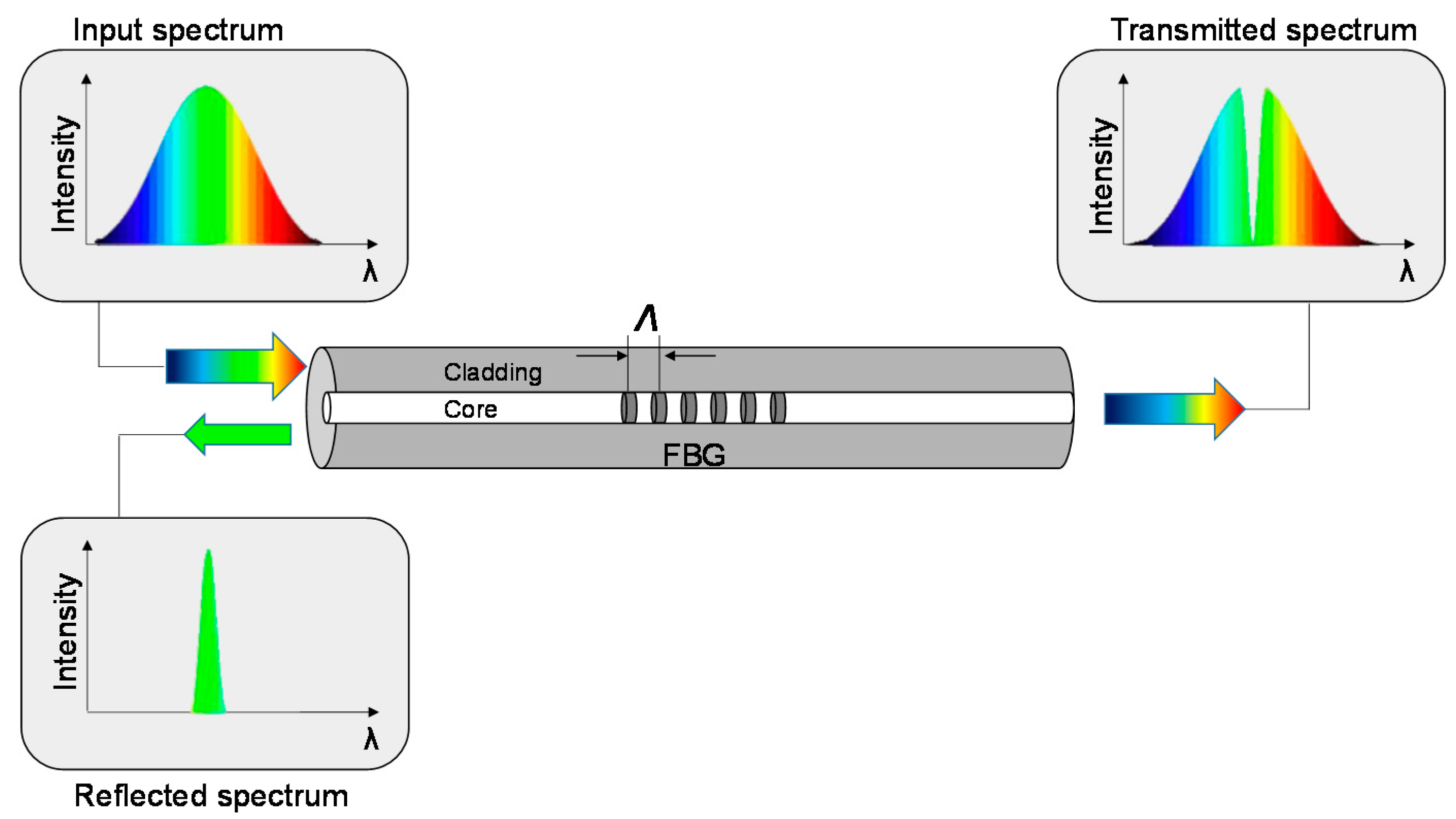
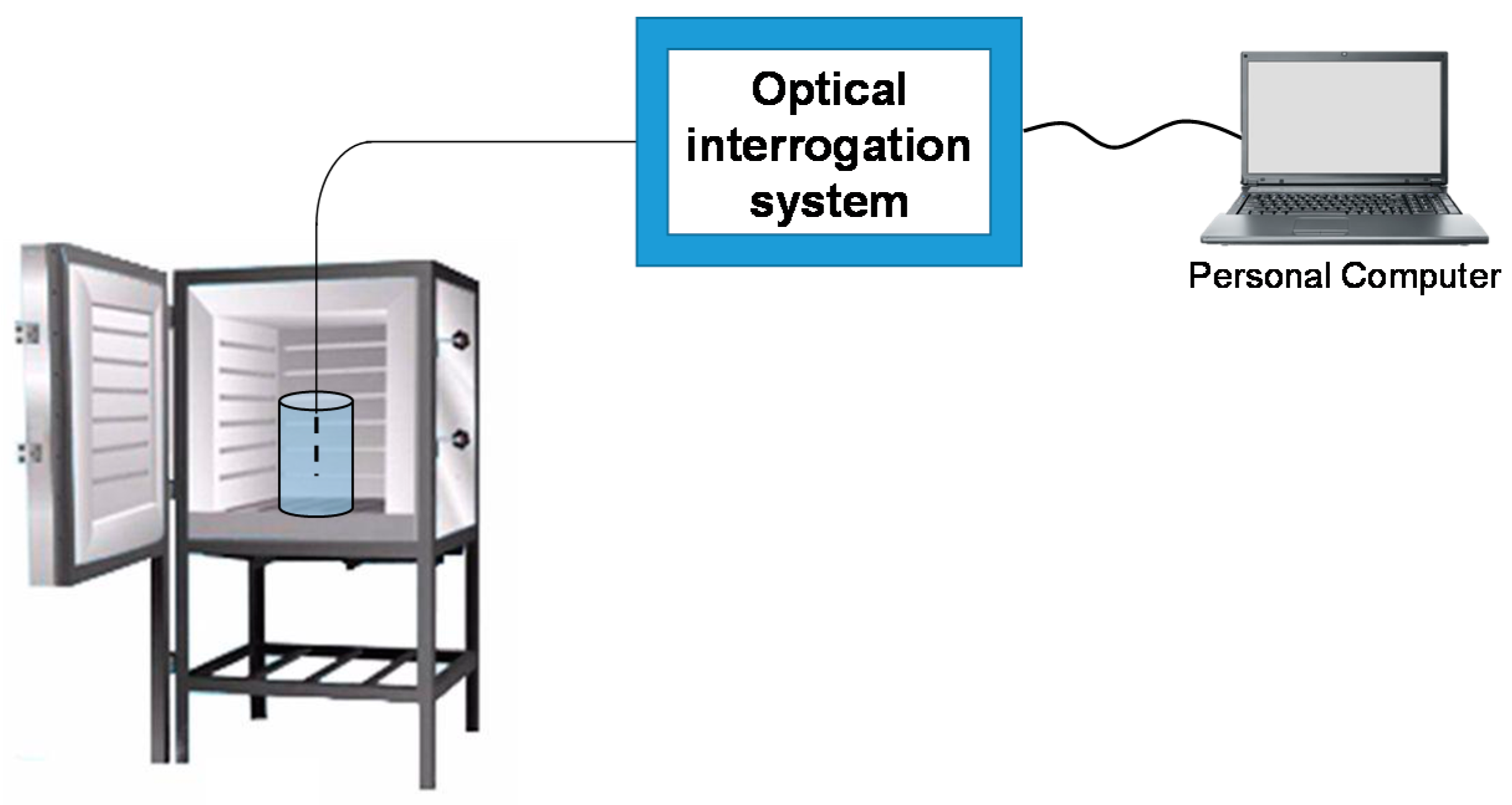
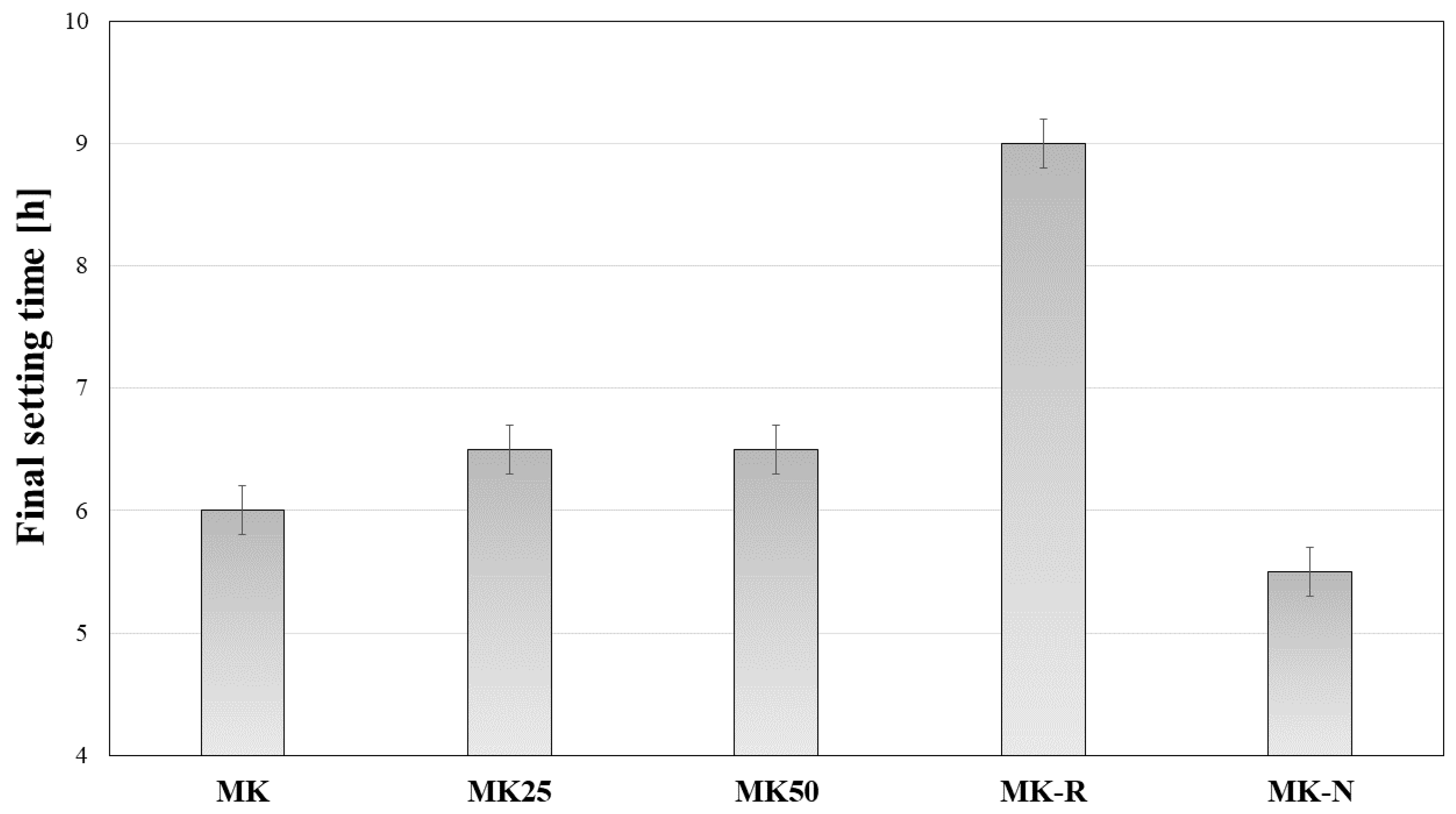
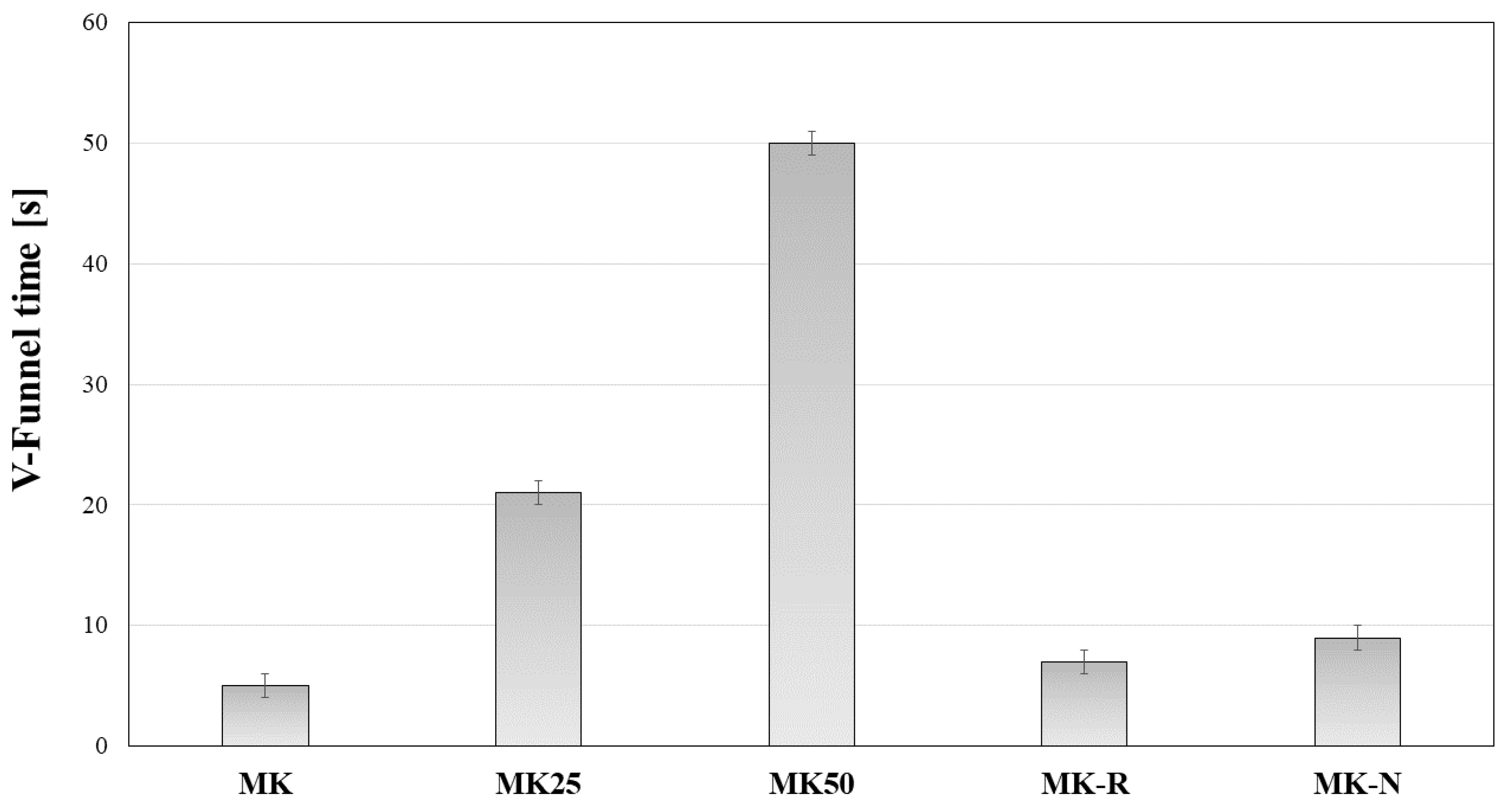
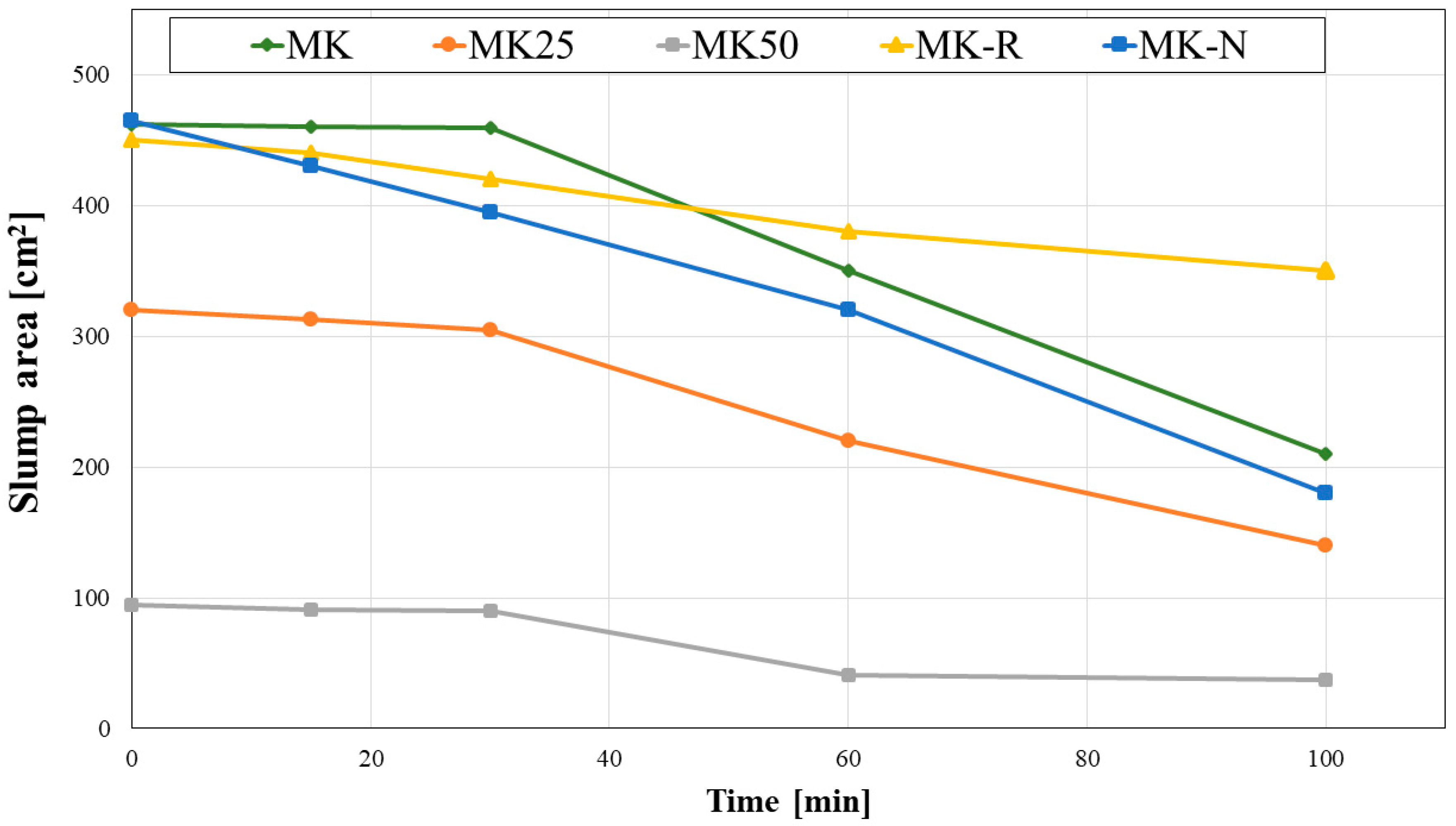
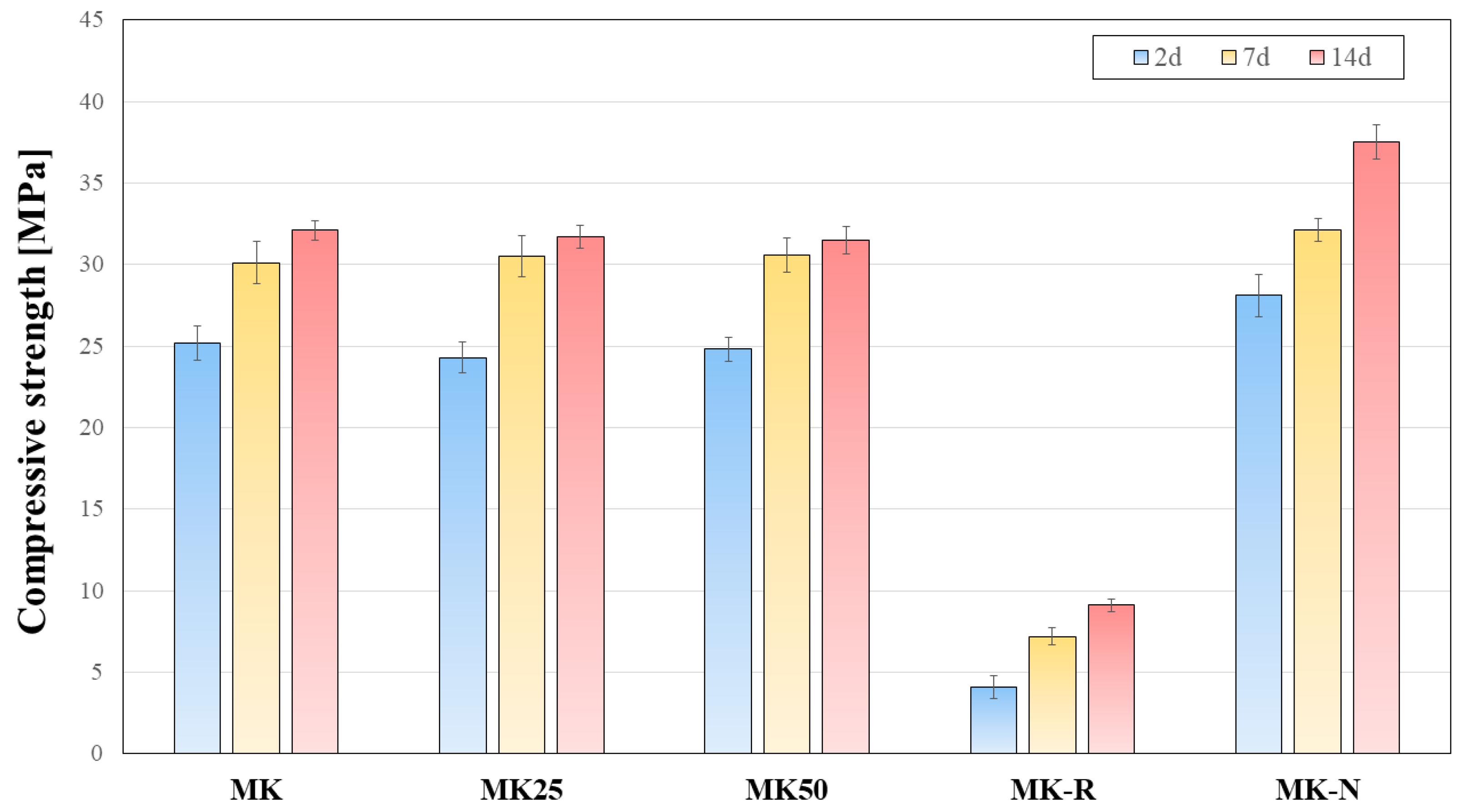
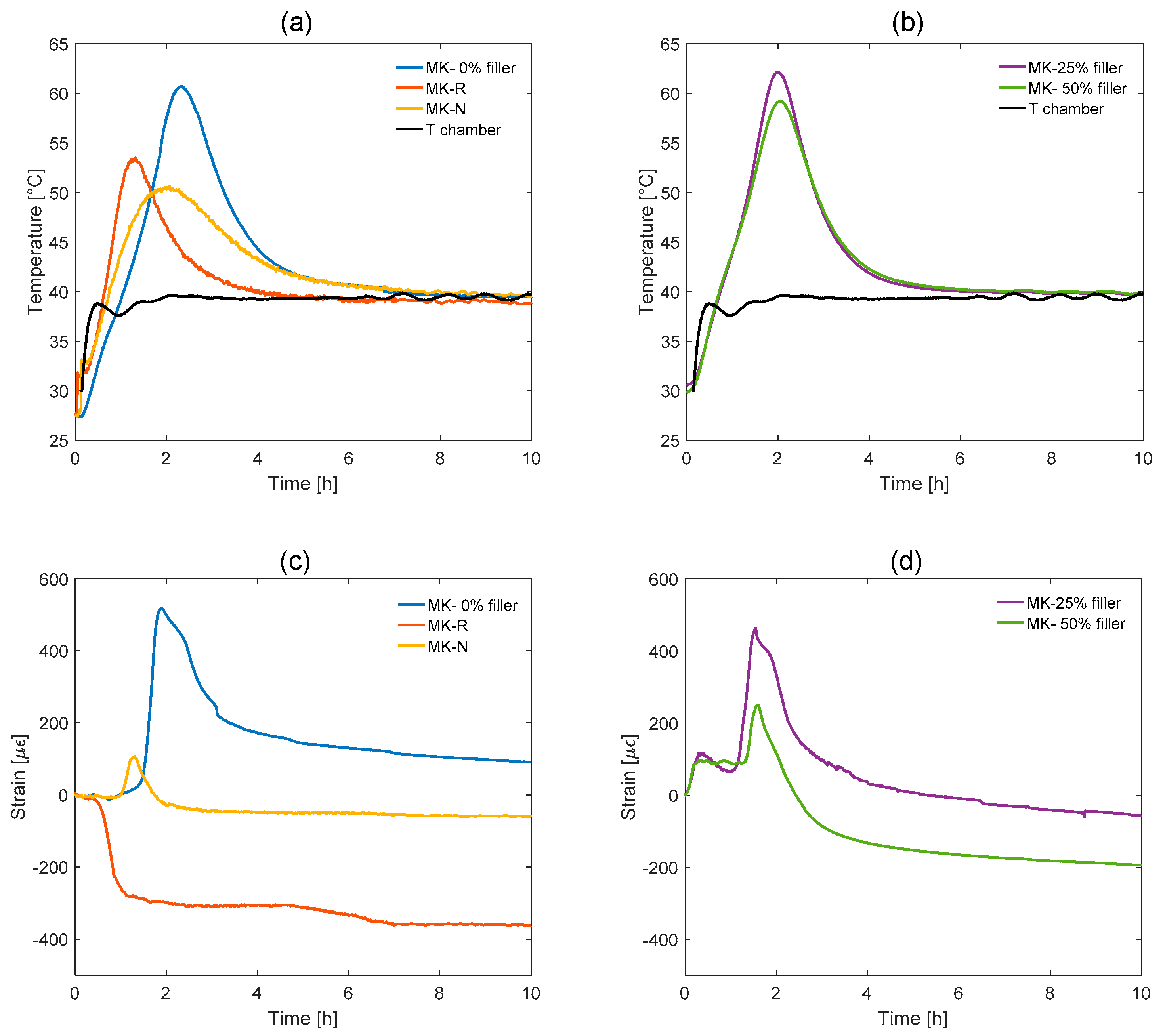
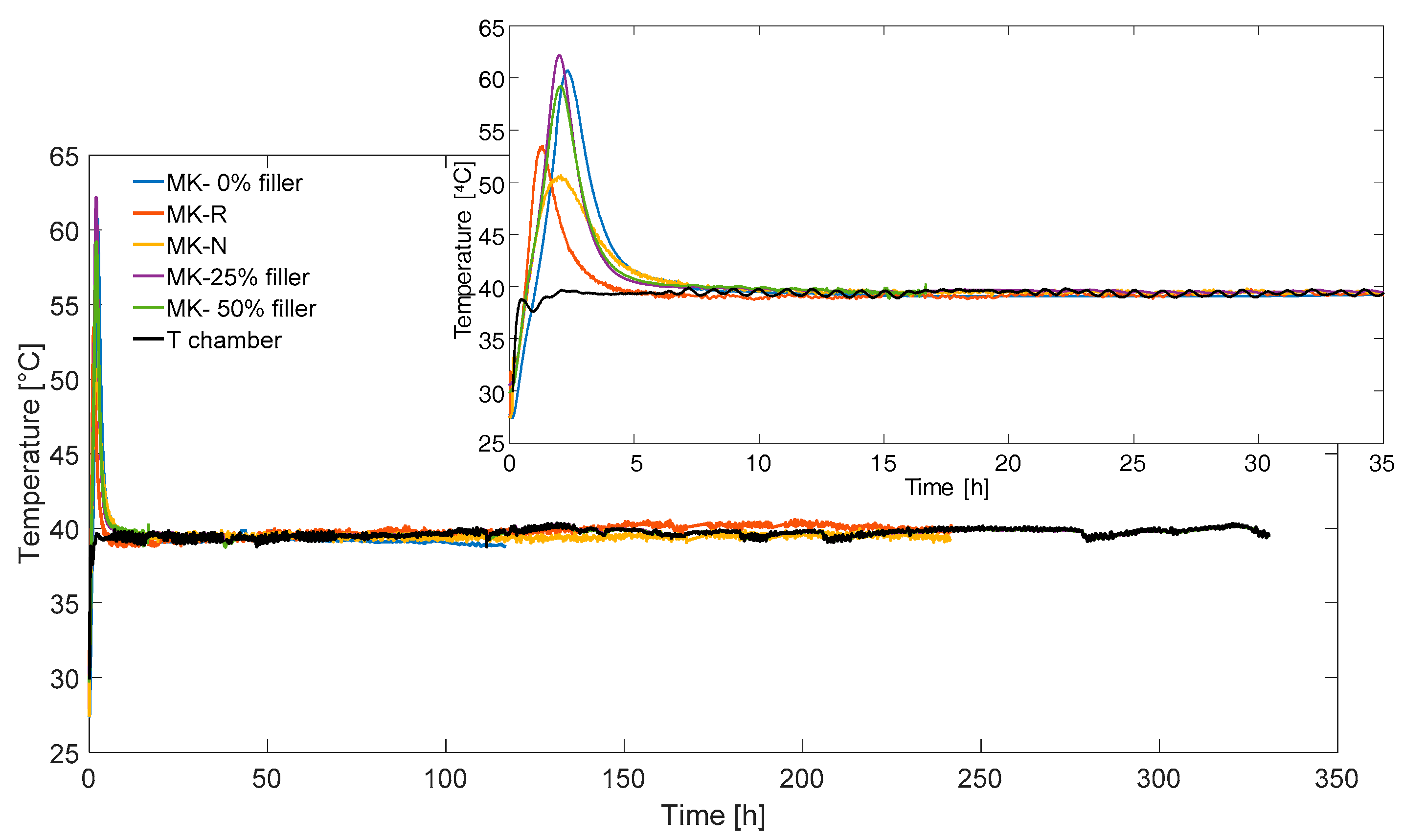
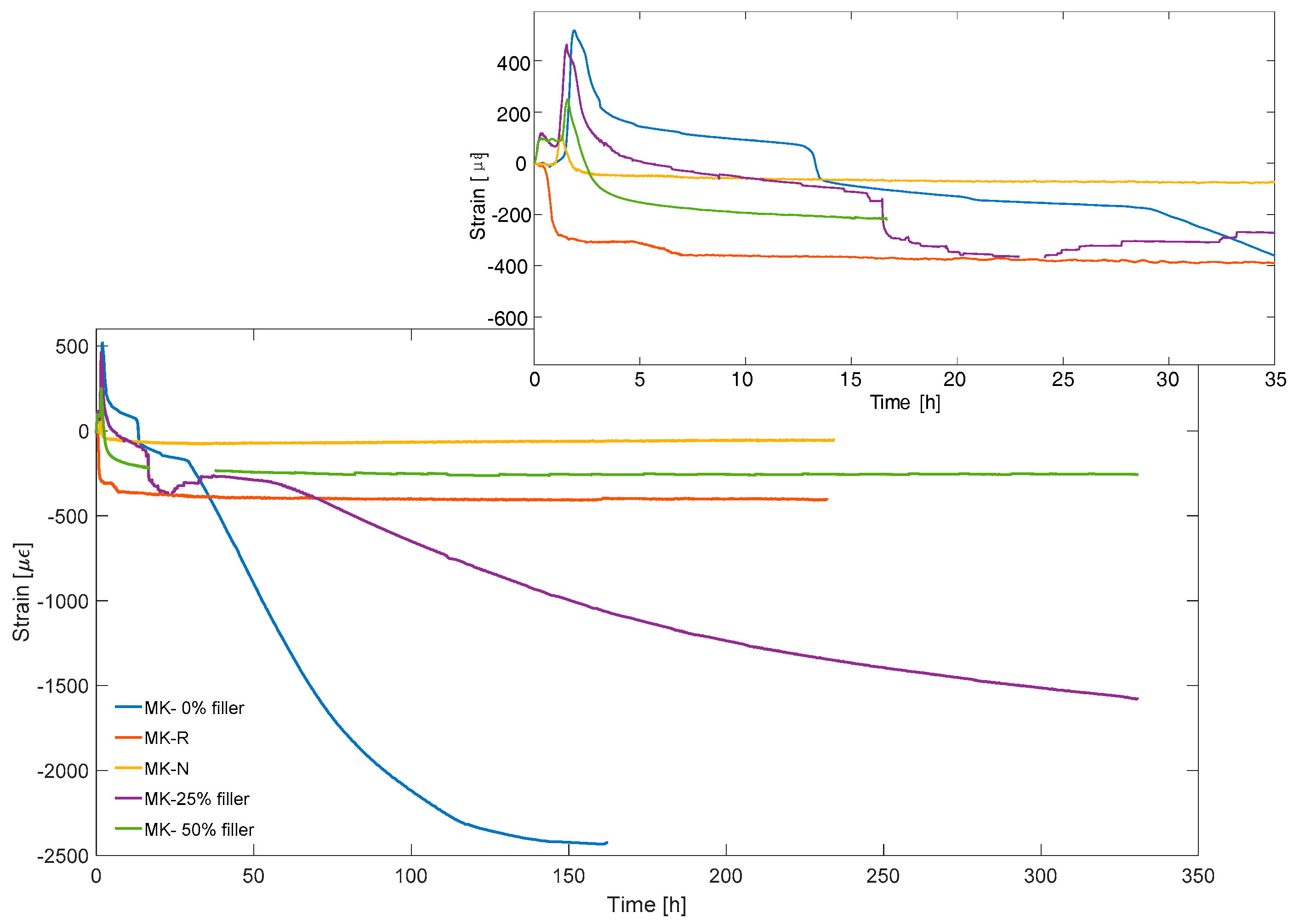
| (g/100 g MK) | MK | MK25 | MK50 | MK-R | MK-N |
|---|---|---|---|---|---|
| Kimia MK | 100 | 100 | 100 | - | - |
| Argeco MK | - | - | - | 100 | - |
| Neuchem MK | - | - | - | - | 100 |
| Sodium silicate | 120 | 120 | 120 | 120 | 120 |
| NaOH pellets | 20 | 20 | 20 | 20 | 20 |
| Filler | - | 25 | 50 | - | - |
| Sample | Temperature | Strain | ||
|---|---|---|---|---|
| Time [min] | Value [°C] | Time [min] | Value [με] | |
| Group 1 | ||||
| MK-0% filler | 138 | 60.7 | 132 | +517.9 |
| MK-N | 120 | 50.6 | 78 | +106.5 |
| MK-R | 78 | 53.2 | - | - |
| Group 2 | ||||
| MK-25% filler | 120 | 62.1 | 73 | +462.6 |
| MK-50% filler | 120 | 59.1 | 73 | +249.9 |
© 2017 by the authors. Licensee MDPI, Basel, Switzerland. This article is an open access article distributed under the terms and conditions of the Creative Commons Attribution (CC BY) license (http://creativecommons.org/licenses/by/4.0/).
Share and Cite
Palumbo, G.; Iadicicco, A.; Messina, F.; Ferone, C.; Campopiano, S.; Cioffi, R.; Colangelo, F. Characterization of Early Age Curing and Shrinkage of Metakaolin-Based Inorganic Binders with Different Rheological Behavior by Fiber Bragg Grating Sensors. Materials 2018, 11, 10. https://doi.org/10.3390/ma11010010
Palumbo G, Iadicicco A, Messina F, Ferone C, Campopiano S, Cioffi R, Colangelo F. Characterization of Early Age Curing and Shrinkage of Metakaolin-Based Inorganic Binders with Different Rheological Behavior by Fiber Bragg Grating Sensors. Materials. 2018; 11(1):10. https://doi.org/10.3390/ma11010010
Chicago/Turabian StylePalumbo, Giovanna, Agostino Iadicicco, Francesco Messina, Claudio Ferone, Stefania Campopiano, Raffaele Cioffi, and Francesco Colangelo. 2018. "Characterization of Early Age Curing and Shrinkage of Metakaolin-Based Inorganic Binders with Different Rheological Behavior by Fiber Bragg Grating Sensors" Materials 11, no. 1: 10. https://doi.org/10.3390/ma11010010






